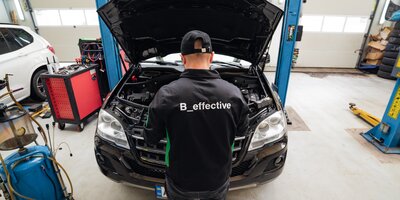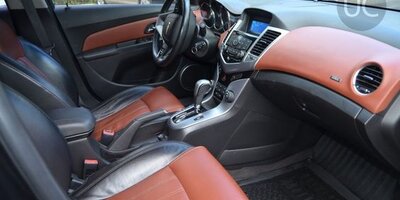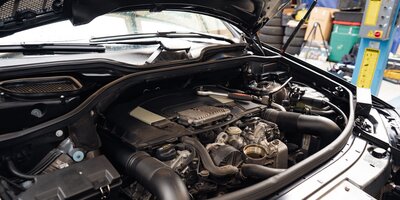WINTER CHECK – TIPS ON HOW TO GET YOUR CAR READY FOR WINTER
Winter is around the corner and colder weather is on its way.
Sub-zero temperatures and a poorly maintained vehicle can be a bad combination and suffer the effects of frost due to:
- frozen water in the washer-fluid reservoir
- condensation in the engine oil
- insufficient antifreeze strength in the cooling circuit
Any water contained in the engine oil – or coolant with insufficient antifreeze content – can freeze, potentially causing extensive and expensive damage. Make sure the engine oil has been changed as scheduled and that the coolant strength is high enough.
To avoid the inconvenience of a breakdown or failure, check your vehicle before winter and the cold weather sets in. Garages offer winter checks to make sure your car is ready for the coldest season of the year and can remedy any faults on the spot, but you can also perform the necessary checks yourself. Here are the most important points to remember.
Seven tips for the winter check
- check and adjust operating fluids
- check the auxiliary drive belts
- check the condition of tyres/rims, tread depth and tyre pressures
- check lighting for function and damage – including headlight aim
- check the windscreen wiper blades and screen washing system
- check electrical components
- check locks/handles for freedom of movement and lubricate
Battery
Fact, car batteries do not perform as well in cold and freezing temperatures. Headlights, screen heating, windscreen wipers and other electrical consumers increase the amount of power required and drain the battery additionally in winter. If the vehicle is only driven over short distances, not only can the alternator not maintain battery charge, but also the increased number of cold starts place excessive load on the battery.
Avoid repeated short journeys, if possible, as even a healthy battery can discharge under such load conditions.
Cold-cranking current test: can be measured at a garage and indicates the battery’s health.
What do you need to do?
A quick test, which you can perform if you own a multimeter, is checking the battery voltage.
Check the battery terminals and earth straps for corrosion. If the battery terminals, earth straps or other electrical connections are corroded or dirty, this prevents electrical energy from flowing freely. The supply of electrical current to the starter motor is critical and even minor causes of electrical resistance can significantly affect starting performance at low temperatures.
What you need: a few hand tools – mainly small spanners or a small socket set, contact cleaner and a multimeter to check battery voltage or alternator output.
Windscreen wipers & washer fluid
Check and adjust the level in the washer fluid reservoir. Add winter washer fluid with antifreeze otherwise you risk the windscreen washer system freezing.
Check the condition of the wiper blades and replace as necessary.
Driving on motorways covered in snow and slush can quickly result in ‘flying blind’ with a dirty windscreen. In the worst case, failure to add winter screenwash can result in the washer reservoir and washer pump being damaged. The wiper blades should also be checked, if they leave streaks or no longer wipe properly, they must be replaced.

Replace worn and split wiper blades
What you need to do?
Use up the summer screenwash in autumn and replace it with winter additive.
What you need: winter screenwash and wiper blades, as necessary.
Lighting
Check lighting for function and damage
Lighting is essential in winter, as daylight is in shorter supply and the sky is often grey even when daylight is available.
What you need to do?
A simple visual check, walk around the vehicle and check that the lights at the front and rear of the vehicle are working and not damaged. You will need a second person to press the brake pedal, so that you can check the function of the brake lights.
Headlight aim should be checked too: this is a job for a garage, because they have the corresponding beam checking/setting equipment.

Professional beam setting tool in garage setting
Coolant
Check and adjust the level and antifreeze strength.
If the antifreeze content in the coolant is insufficient, the cooling system can freeze and costly damage can result. But even at temperatures above freezing, it is essential to maintain the correct coolant mixture ratio. Caution, when choosing antifreeze consult the owner’s manual and follow the manufacturer’s recommendations. Only mix coolants of a compatible type, otherwise, the cooling circuit could be damaged.
What you need to do?
Check the level in the expansion tank and adjust as necessary, the coolant should be just under the MAX mark. Check the freezing point of the coolant with an antifreeze tester and add neat antifreeze if necessary.
What you need: an antifreeze tester – an inexpensive and readily available tool
Auxiliary drive belt(s)
Check the belts for wear and tension. Auxiliary drive belts often drive critically important components, such as the water pump, alternator or power-steering pump. As the auxiliary drive belts perform such an important task, the condition must be checked to ensure that the belts do not fail. What you are looking for is cracks in the V-grooves or outer surface of the belt or even chunks of rubber missing from the belt.
What you need to do?
Visually inspect the belts for wear and damage, use a torch as necessary.
If the belt is slack, adjust belt tension if possible. If the belt is damaged or worn, obtain a new belt and replace the existing belt.

A belt displaying damage like this must be replaced.
What you need: a torch and, if necessary, spanners or a socket set for belt replacement
Tyres
Check the overall condition of the tyres. Make sure that there are no bulges, no nails or similar lodged in the tread, no cuts or damage to the sidewalls or carcass, no exposed belts and that the tread depth is sufficient; at least 1.5 mm. Damage that could result in a puncture or sudden deflation must be remedied immediately!
Underinflated tyres pose a risk, as underinflation can lead to the following:
- longer stopping distances
- decreased vehicle stability
- rim damage – the sidewall can no longer protect the rim
- sidewall damage
- tyre failure
In wintry weather, make sure you have the right tyres. Summer tyres are not designed for cold weather – they have a hard rubber compound and the tread pattern is less suited to wintry conditions. Sufficient tread depth and the correct tyre pressure settings are also essential for stable handling.
What you need to do?
Change to winter tyres in good time, check and correct the correct tyre pressure, the values can be found in the owner’s manual, inside the fuel filler cap or on a sticker on the B-pillar. Tyre tread depth is best measured with a tread depth gauge.
What you need: tyre-pressure gauge, which can be found at the nearest filling station, and a tread-depth gauge.

Tread depth should be at least 1.5 mm across the width of the running surface.
When the list of checks has been completed, your vehicle is ready for the rigours of winter.

You might also like

The modern marvel of an internal combustion motor powers our vehicles, providing the strength and reliability we rely on for daily transportation. However, just like anything else subjected to constant use, motorized units experience wear and tear over time. Component deterioration can significantly impact performance and longevity. In this article, we will delve into the intricacies of engine wear meaning, explore the various causes behind it, provide actionable tips to reduce and prevent it. Furthermore, we will look at how specialized engine oils, such as BIZOL, play a crucial role in safeguarding your engine’s health. Let’s begin by understanding what engine wear is and the factors that contribute to it.

The melodious purr of a motor, the velvety transition of cog-wheel, and the elegant voyage along the expansive highway — these are the unmistakable characteristics of a meticulously calibrated self-shifting gearbox system. But what transpires when the motorized ensemble falters, the cogs gnash, and the voyage veers into an unforeseen tempest? Get into the realm of automatic transmission problems, a domain where automotive aficionados and everyday motorists alike encounter the enigmatic intricacies of this complex system.

Driving is a blend of exhilaration and convenience, but sometimes, your trusty car can hit a snag. One of the most frustrating issues is a coolant leak.
Coolant, often referred to as the versatile 'antifreeze,' assumes the uncelebrated role of an automotive guardian, ensuring your engine's harmonious operation. This unassuming fluid stands as a bulwark against the scorching summer heat and the bone-chilling cold of winter. Nevertheless, when the vigilance of antifreeze wanes, and it embarks on an unauthorized journey beyond its confines, ominous troubles come into view.

